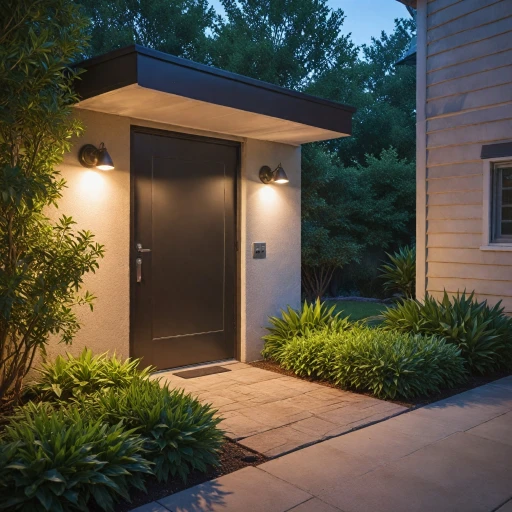How Motion Detection Enhances Security
Enhancing Security with Motion Detection
Motion detection plays a crucial role in enhancing the security of your home or business. By utilizing advanced technology, these systems can detect movement and trigger alerts, allowing you to respond promptly to potential threats. Whether you're using a Ring camera or exploring other brands like Lorex or Blink, the integration of motion detection significantly boosts the effectiveness of your security setup.
Motion detection cameras, such as those equipped with smart motion technology, offer several advantages:
- Immediate Alerts: When motion is detected, the camera sends instant notifications to your smartphone app, enabling you to view the live video feed and assess the situation.
- Efficient Monitoring: These cameras reduce the need for constant manual surveillance by automatically recording only when activity is detected, saving storage space and making it easier to review footage.
- Integration with Smart Home Systems: Many motion detection cameras work with Alexa and Google, allowing for seamless integration with other smart devices in your home.
- Versatility: From outdoor floodlight cams to indoor dome cameras, motion detection is a feature that enhances a wide range of camera systems.
For those interested in the technical aspects of motion detection, exploring the benefits of infrared spotlights in Ring cameras can provide further insights into how these systems function effectively in various lighting conditions.
Key Features of Motion Detector Sensor Cameras
Essential Features of Motion Detection Cameras
When it comes to security cameras, motion detection is a game-changer. These systems are designed to alert you to any unusual activity, making them an integral part of smart security solutions. Here are some key features that define motion detector sensor cameras:
- Smart Motion Alerts: Modern cameras, like those from Ring and Blink, are equipped with smart motion sensors that can differentiate between humans, animals, and other moving objects. This reduces false alarms and ensures that you are notified only when necessary.
- Integration with Smart Home Systems: Many security cameras work with Alexa and Google Assistant, allowing you to control them using voice commands. This integration enhances the convenience and functionality of your security system.
- Night Vision Capabilities: Cameras with color night vision provide clear video footage even in low-light conditions. This is crucial for outdoor security, where lighting can be unpredictable.
- Cloud Storage Options: Security cameras often come with cloud storage options, allowing you to store video footage securely. This feature ensures that you can access your recordings from anywhere, anytime.
- Customizable Detection Zones: Some systems allow you to set specific areas for motion detection. This means you can focus on critical zones, like entrances or driveways, and ignore less important areas.
- Advanced Video Analytics: Features like license plate recognition and facial recognition are becoming more common, providing an additional layer of security.
- Weather Resistance: Outdoor cameras are designed to withstand harsh weather conditions, ensuring consistent performance regardless of the environment.
Understanding these features can help you choose the right camera system for your needs. As you explore different brands, like Lorex or CCTV cameras, consider how these features align with your security goals. Remember, the right motion detection system can significantly enhance the safety and security of your property.
Challenges in Using Motion Detection Cameras
Potential Limitations in Motion Detection Technology
While motion detection in security cameras, such as those from Ring, provides a significant boost to home security, there are several challenges that users may encounter. Understanding these limitations can help in making informed decisions when setting up your security systems.
- False Alerts: One of the most common issues with motion detection cameras is the occurrence of false alerts. Factors such as moving branches, passing cars, or even changes in lighting can trigger the motion sensor, leading to unnecessary notifications. This can be particularly troublesome in outdoor settings where environmental factors are more variable.
- Limited Detection Range: The effectiveness of a motion detection system can be limited by its range. Some cameras may not detect motion accurately beyond a certain distance, which can be a concern for those needing to monitor larger areas. Comparing models like Ring with others such as Lorex or Blink can help identify which offers the best coverage for your needs.
- Privacy Concerns: As with any smart security system, there are privacy considerations. The continuous recording and cloud storage of video footage can raise concerns about data security and unauthorized access. Ensuring your camera systems are NDAA compliant and have robust security features is crucial.
- Integration with Other Devices: While many cameras, including Ring, work with Alexa and other smart home systems, compatibility issues can arise. Ensuring your devices are fully integrated and function seamlessly with apps and other smart home components is essential for optimal performance.
- Environmental Factors: Weather conditions can impact the functionality of motion detection cameras. For instance, heavy rain or fog can obstruct the camera's view, affecting its ability to detect motion accurately. Investing in cameras with features like color night vision or floodlight capabilities can help mitigate these issues.
Addressing these challenges involves careful consideration of the environment and specific security needs. By optimizing your motion detection settings and choosing the right camera systems, you can enhance the effectiveness of your security setup. For those interested in further enhancing their home security, exploring solutions like a 110v LED controller remote might offer additional benefits.
Comparing Ring Cameras with Other Brands
Comparative Analysis: Ring vs. Competitors
In the realm of motion detection security cameras, Ring stands out for several reasons. To get a clear picture of how Ring cameras measure up against competitors like Lorex, Blink, and traditional CCTV systems, it's essential to look into various factors such as camera quality, detection systems, and user interface.
Firstly, Ring cameras are renowned for their integration with Alexa, offering voice-activated controls for greater convenience. This is not only beneficial for indoor smart security but also for outdoor surveillance where quick commands can be crucial. Camera systems integrated with Alexa and Google can streamline security operations, making Ring a preferred choice for users who value a seamless smart home experience.
When comparing motion detection capabilities, Ring's smart motion sensors are designed to minimize false alerts. This feature, combined with their sophisticated app interface, allows users to fine-tune settings through the cloud, offering a tailored security surveillance experience that some competitors might lack.
Moreover, Ring cameras provide night vision capabilities that enhance security during nighttime. Although Blink and Lorex also offer night vision, the integration of features like floodlights and color night vision can set Ring apart. Additionally, Ring's floodlight camera is highly sought after for outdoor use, providing broader visibility and enhanced security.
Price is another factor to consider. While Ring offers a range of camera price points, they tend to be competitively priced considering the advanced technology features they incorporate. Although some users might find CCTV systems or dome cameras from other brands to be less expensive upfront, the value offered by Ring's smart camera functionalities and app support is significant in long-term security systems.
Finally, Ring’s commitment to innovation is evident in its easy-to-use app and smart home integration features, maintaining its position amidst a crowded market. Optimizing motion detection settings can further enhance user experience, aligning with future trends in motion detection technology.
Tips for Optimizing Motion Detection Settings
Maximizing Efficiency with Motion Detection in Cameras
Optimizing your ring camera’s motion detection settings can greatly enhance the performance of your security systems. Here are some practical tips to keep in mind when fine-tuning these settings:- Customize Motion Zones: Most security cameras, including Ring, offer the option to customize motion zones. By highlighting only specific areas where you want motion to be detected, you can prevent unnecessary alerts. For instance, focus on entry points like doors or windows, and rule out places where there’s continuous movement, like trees swaying in the wind.
- Adjust Sensitivity Levels: Depending on the environment, adjust the sensitivity of the motion sensors to avoid false alarms. High sensitivity may detect even the slightest motion, such as small animals or passing vehicles, leading to unwanted alerts. Experiment with different sensitivity settings to find the optimal balance for your outdoor or indoor setup.
- Scheduling Motion Detection: Utilize scheduling features available in your camera app to activate and deactivate motion alerts during specific times. This is particularly useful if your daily activity routines can trigger unwanted detections, like morning traffic or nightly critters.
- Integration with Smart Home Devices: Enhance your system security by integrating your cameras with smart devices. For example, having a floodlight cam activate in response to detected motion can deter potential intruders. Moreover, linking with smart assistants like Alexa allows voice control over your motion settings, making the system more user-friendly.
- Review and Adjust Based on Past Alerts: Frequently review your motion detection alerts. If some alerts are unnecessary, adjust the settings accordingly. This iterative approach allows you to refine the detection parameters over time, ensuring that your camera systems remain effective and efficient.
- Leverage Smart Features: Some advanced systems, like those from Lorex or Blink, offer smart motion detection capabilities that can differentiate between people and other moving objects, such as pets or vehicles. Utilizing these intelligent features helps in reducing false alarms and improves the accuracy of the alerts.
Future Trends in Motion Detection Technology
Anticipating Advancements in Motion Detection Technology
The future of motion detection technology in security cameras holds promise for enhanced security, efficiency, and ease of use. There are a number of trends and developments that suggest where these innovations are heading.- Artificial Intelligence Integration: AI-powered algorithms are being increasingly integrated into security devices, enabling cameras to learn and differentiate between types of motion. This could mean distinguishing between a falling leaf and an intruder, reducing false alarms and improving the overall reliability of the system.
- Enhanced Connectivity: With the growing ecosystem of smart systems, cameras are likely to offer more seamless integration with platforms like Alexa and Google, allowing homeowners to control and view security footage through voice commands and other smart devices.
- Higher Quality Video Features: Cameras are expected to have improved video quality, including advancements in color night vision and pan-tilt features, allowing for more comprehensive, clear, and detailed security footage.
- Improved Cloud and Storage Solutions: With more security cameras supporting real-time video streaming, innovations in cloud storage will likely make it more efficient and cost-effective to store and access large amounts of security video data.
- NDAA Compliance: As more security cameras become NDAA compliant, the focus on maintaining both privacy and security will result in more trusted and reliable options for users.
- Smart Motion Identification: Cameras will advance in smart motion detection, identifying specific objects, such as license plates or faces, contributing to more targeted and actionable security alerts.
- Renewed Focus on Price & Accessibility: Despite technological advancements, the price point remains a crucial factor. Ensuring advanced features remain affordable will likely be a significant aspect of future developments.



